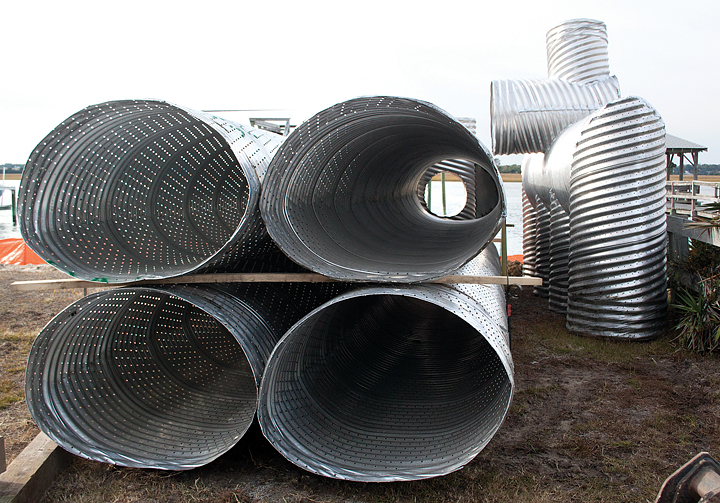 The sweltering late summer months in Wrightsville Beach tend to follow a particular weather routine. Ominous storm clouds form around 4 p.m., rumbling warnings to beachgoers and eventually dumping rain over the island. Rainwater washes over oily roads and sidewalks, through outflow pipes and directly into the surrounding waters. Bacteria levels in coastal waters rise and occasionally, swimming advisories are issued.
The sweltering late summer months in Wrightsville Beach tend to follow a particular weather routine. Ominous storm clouds form around 4 p.m., rumbling warnings to beachgoers and eventually dumping rain over the island. Rainwater washes over oily roads and sidewalks, through outflow pipes and directly into the surrounding waters. Bacteria levels in coastal waters rise and occasionally, swimming advisories are issued.
Not only does the summer heat lead to rainstorms, but the high temperatures inside the stormwater outflow pipes also create an ideal home for bacteria, which are then washed into the coastal waters with every rainfall.
“It just acts like a Petri dish,” Wrightsville Beach’s stormwater manager Jonathan Babin said, adding the problem exists in the winter as well. “You can climb down there and it will be 85 degrees in there when it’s 40 out here. They have that incubator because of the sun hitting the asphalt.”
Babin, working with the North Carolina Coastal Federation, the University of North Carolina Wilmington and the City of Wilmington, has devised and put into action a plan to reroute the stormwater and eliminate its impact on coastal waters. Using grant money from the National Estuarine Research Reserve, Babin has helped oversee the installation of six stormwater retrofit projects on town property throughout Wrightsville Beach.
The projects are subtle; many residents likely walk past them every day without noticing. An earthen check dam was created in the swale beside Salisbury Street near the Wrightsville Beach Museum driveway. The berm blocks the water from entering outflow pipes, causing it to infiltrate the soil instead.
“It’s really simple, but really effective and it will pre-treat all that stormwater,” said Tracy Skrabal, coastal scientist and office manager for the coastal federation’s southeast regional office. “Any town, any municipality, any property owner could do this. It’s not expensive.”
Down the road at the corner of Municipal Lane and Salisbury Street is a more traditional rain garden. The native plants and sandy soil help soak up stormwater before it reaches the nearby pipe. Babin said the high visibility of this particular project would also provide an educational opportunity.
“It’s a great place to put some plants where someone would actually notice it,” he said. “And this one was probably particularly bad because of the recycling center.”
Three more retrofit sites have been created near Causeway Drive across from Mellow Mushroom to prevent stormwater flowing into Motts Channel. On the north side of the road, two inlets containing prefabricated boxes were installed on either side of the existing drain to catch rainwater and divert it to the nearby field at Wrightsville Beach Park.
In the median, two concrete troughs were built to funnel stormwater from the road into the grass. Then, on the south side of Causeway Drive, the ground was regraded to collect rainwater.
The final retrofit project involved replacing part of the outflow pipe located at Iula Street. Before retrofitting, the pipe was one of many that collected stormwater off Waynick Boulevard and surrounding areas and dumped it directly into Banks Channel. The Iula Street pipe was chosen because it is on town property; the rest are located on private residential lots and therefore would require permission from the property owners to retrofit.
The property owners should have a vested interest in future of these outflow pipes, Skrabal pointed out, as they are likely the ones swimming in the water close to where the pipes dump stormwater.
“People who want to see this water stay clean will have to jump in,” Skrabal said. “You would hardly expect a private property owner to pay the kind of money we came up with through grants, but you could ask them to allow us passage or even be an advocate for it.”
The alterations to the Iula Street outflow pipe create no visible changes to the land, Babin added, as the pipe is underground. Most of the old pipe was cut out and replaced by a maze of porous pipes that allow the stormwater to seep slowly into the surrounding rocks and sand. Outside of a massive rain event, no stormwater would ever reach Banks Channel from this pipe, Babin said.
At each project location, the old drains and pipes have been left in place to catch overflow and prevent flooding in the event of an extremely heavy rainfall. UNCW’s Dr. Mike Mallen will test bacteria levels in local waters in spring 2015 and compare them to baseline measurements to give the town and residents a precise measure of the project’s effectiveness.
In addition to the town’s efforts, the North Carolina Coastal Federation encourages residents to install rain gardens on their properties. The coastal federation recently offered a DIY Rain Garden Workshop and Skrabal said they plan to hold more.
Andy and Janet McGlinn attended the class and created a rain garden in their backyard. Using shovels, they dug an indentation and planted local shrubbery. They said they worked a few hours every day for a week and the total cost was around $100.
“We’re older, we’re middle-aged, and we didn’t have any power equipment or anything,” Janet McGlinn said. “It was so worth the time and effort. We are actually thinking about doing our front yard.”
email [email protected]




